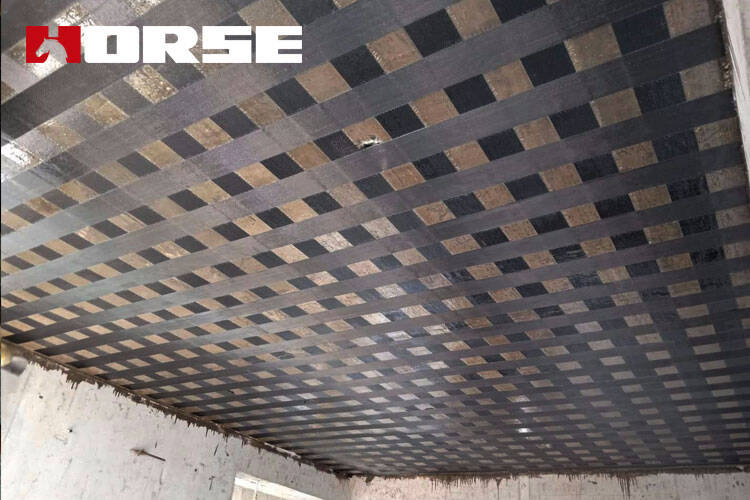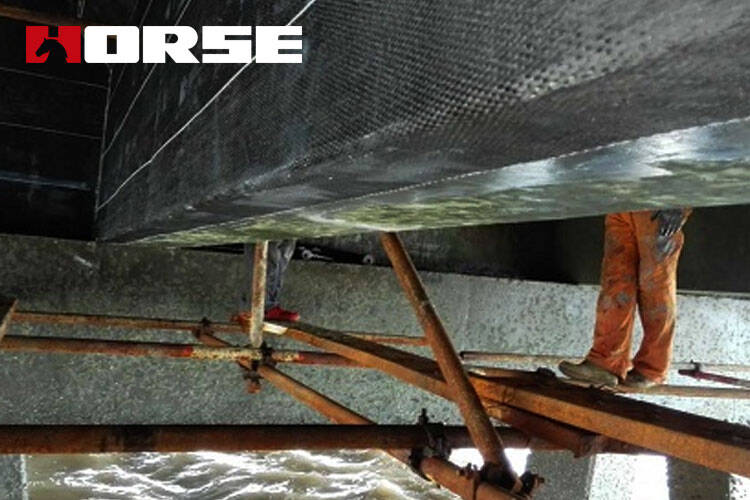Solutions
Horse Construction offers full range of structural strengthening materials with technical supports, documentation supports, products supports, project supports.
Carbon Fiber in Structural Reinforcement and Retrofitting Engineering

Application advantages of carbon fiber in building structure reinforcement and retrofitting project
Compared with the previous reinforcement methods, the effect of carbon fiber for struatural reinforcement and retrofiting is better and remarkable. Especially in old buildings, people use carbon fiber materials to reinforce the internal prestressed hollow slabs of old houses. Carbon fiber reinforcement does not require the application of large mechanical equipment, and the reinforcement efficiency is high and the noise is low.
Analyze the technical advantages of carbon fiber reinforcement, mainly as follows:
① It has a wide range of applications. Carbon fiber can replace shear steel and bending steel, and can also be used in civil residential or industrial buildings to prevent earthquakes and cracks, and can also reinforce anti-corrosion structures;
②The carbon fiber has a waterproof effect. In the carbon fiber reinforcement, epoxy resin is used to treat the surface of the concrete. The epoxy resin itself has good waterproof performance, so the carbon fiber reinforcement method will also have a strong waterproof ability;
③The construction of carbon fiber reinforcement is convenient, and the carbon fiber material is light and thin. It does not require the application of complex engineering machinery when using it. The construction personnel can do it manually. The application of carbon fiber reinforcement can also effectively shorten the engineering cycle;
④ The carbon fiber reinforcement method is easy to cut at will. According to the actual reinforcement requirements of the building structure, the carbon fiber is cut at will, and the reinforced carbon fiber material will not affect the appearance of the building structure;
⑤The carbon fiber reinforcement method has strong corrosion resistance. Due to the stable performance of carbon fiber materials, it will not be affected by the external environment in the application, which can effectively extend the service life of the building structure.
Practical application of carbon fiber in reinforcement engineering of building structure
1) Application of carbon fiber reinforcement in a variety of concrete load-bearing members
Based on the above content, we understand the advantages of carbon fiber reinforcement methods, and a reasonable selection of bonding materials will help ensure the full play of the combined force of carbon fiber and concrete. Therefore, carbon fiber reinforcement can meet the high demand for reinforcement and reinforcement of concrete stressed members.
First, carbon fiber reinforced concrete flexural members. People have conducted tests on this carbon fiber reinforcement method and found that the strength of the concrete members after the reinforcement of carbon fiber materials has increased, and the load-bearing capacity of the members has increased. When the component cracked, the crack width was found to be smaller. When the bearing capacity of the carbon fiber reinforced part reaches its limit, the number of cracks produced by the flexural member of the concrete front section is reduced, and the distribution of the cracks on the concrete surface is more even.
Secondly, carbon fiber reinforced concrete compression members. The carbon fiber material is wound on the concrete square column, and the uniformity of the carbon fiber material should be ensured when winding, so as to increase the load capacity of the square column and maximize the stability of the concrete square column structure. In addition to the concrete square columns, the use of carbon fiber reinforcement on the concrete columns can also increase the bearing capacity of the columns. In the carbon fiber reinforcement method under load, the concrete will have compression deformation problems after being stressed. However, carbon fiber reinforcement has a constraining effect, which can provide a certain lateral constraining force for the concrete compression members, allowing the compression members to confine the concrete and improve the bearing capacity of the members.
Finally, carbon fiber reinforced concrete oblique section shear members. The application of carbon fiber materials in the reinforcement and transformation of old buildings can improve the shear resistance of concrete structures. The construction personnel scientifically select the reinforcement method and anchoring method, and set the reinforcement amount reasonably, which can improve the shear resistance of the concrete members of the building. In the traditional carbon fiber reinforcement method, people use the method of winding and pasting to maximize the advantages of the carbon fiber material to achieve the expected reinforcement effect and strength, and the shearing effect of the concrete structure brought by this reinforcement method is also very ideal. However, the winding and pasting method of carbon fiber reinforcement also has certain drawbacks. The process of reinforcement construction is complicated and the construction personnel cannot complete it in a short time. Therefore, it is recommended that construction personnel use U-shaped carbon fiber to paste concrete shear-resistant members to achieve the best reinforcement effect.
2) Steps and process flow of carbon fiber reinforcement
Before the carbon fiber reinforcement construction, the surface of the building structure should be treated with the base layer. Subsequently, the adhesive is prepared according to the actual requirements, and a primer is applied to the surface of the reinforced part to ensure that the smoothness of the surface meets the requirements, and then a layer of adhesive is applied. Lay a fiber cloth and a protective layer on it using the adhesive. In order to ensure the reinforcement quality of carbon fiber materials, construction personnel should do a good job of cleaning the grassroots before reinforcement. Clean up all the impurities attached to the surface of the structure, leaving only the solid part of the concrete structure of the building. If there are defects, they should be repaired in time to ensure that the surface of the structure is flat. If cracks occur on the surface of the building's reinforcement members, it is recommended that the construction personnel fill in the actual crack size and seal the place. After polishing the surface of the concrete structure smoothly, remove the floating ash on the surface in time, and at the same time polish the corner paste to ensure that the corners of the concrete structure are round. The deployment of the adhesive should be carried out in accordance with the actual construction conditions, combined with the ambient temperature and humidity, to ensure the reasonable storage of the adhesive, and there should be no direct sunlight during the storage process.

3) Engineering case analysis of carbon fiber reinforcement
When carrying out structural reinforcement of old buildings and residences, you should first understand the specific structure of the building. Through the appraisal of the use of the building, combined with the appraisal results, a scientific and reasonable reinforcement plan is formulated.
During the construction of a building renovation project in Suzhou City, the construction unit proposed a plan for strengthening the beams with building carbon fiber cloth. During the construction, people completed the carbon fiber reinforcement project by treating the base material, pasting the carbon fiber cloth at the bottom of the beam, and pasting the U-shaped hoop. When processing the base material, the construction personnel use power tools to polish the concrete base surface to remove the convex hulls and sharp corners of the stones. The right-angle area at the bottom of the beam is polished into an arc shape with a rounding radius ≥20mm. Subsequently, the construction staff first paste the construction carbon fiber cloth under the beam, and select the corresponding construction carbon fiber cloth according to the width of the beam. When encountering a beam with a width of 350mm, because the width specification of the construction carbon fiber cloth is not 350mm, the construction carbon fiber cloth of the 200mm×150mm specification is not left empty or lapped together. The bottom of the beam should be pasted with 3 layers of I-level construction carbon fiber cloth. Paste U-shaped hoops at intervals required by drawings or specifications. The U-shaped construction carbon fiber cloth is 20cm wide, and the paste construction is in accordance with the required 10cm net spacing, that is, the distance between the side of the construction carbon fiber cloth is 10cm. The construction staff added a 15cm wide carbon fiber layer on the top of the beam. Within 1~2h after the pasting area is pasted, evenly sprinkle coarse sand on the pasting area to facilitate subsequent application of mortar.
Conclusion
All in all, carbon fiber materials are a new type of reinforcement material in the construction industry, and the application of carbon fiber materials in structural reinforcement and retrotitting has obvious technical advantages. Compared with traditional building structure reinforcement, carbon fiber reinforcement has lower requirements for construction operations, without the use of large-scale equipment, and manual operation is sufficient. In addition, the construction steps are convenient for carbon fiber reinforcement, and the construction process is clear, which will not affect the building structure itself during construction, and can improve the stability and safety of the building structure.
You can find anything here you are in need of, have a trust trying on these products, you will find the big difference after that.

High strength, unidirectional carbon fiber wrap pre-saturated to form a carbon fiber reinforced polymer (CFRP) wrap used to strengthen structural concrete elements.

High strength, unidirectional carbon fiber fabric pre-saturated to form a carbon fiber reinforced polymer (CFRP) fabric used to strengthen structural concrete elements.

High strength, unidirectional carbon fiber sheet pre-saturated to form a carbon fiber reinforced polymer (CFRP) sheet used to strengthen structural concrete elements.